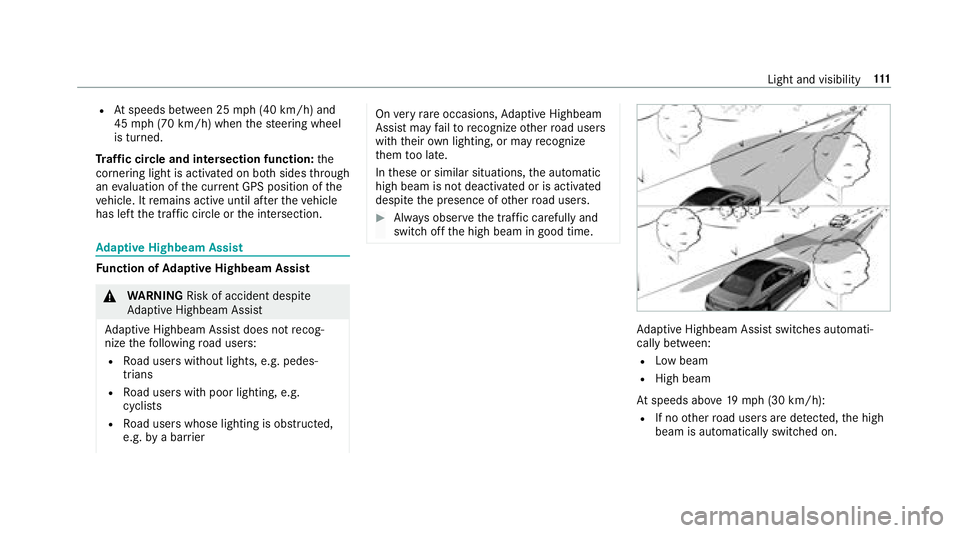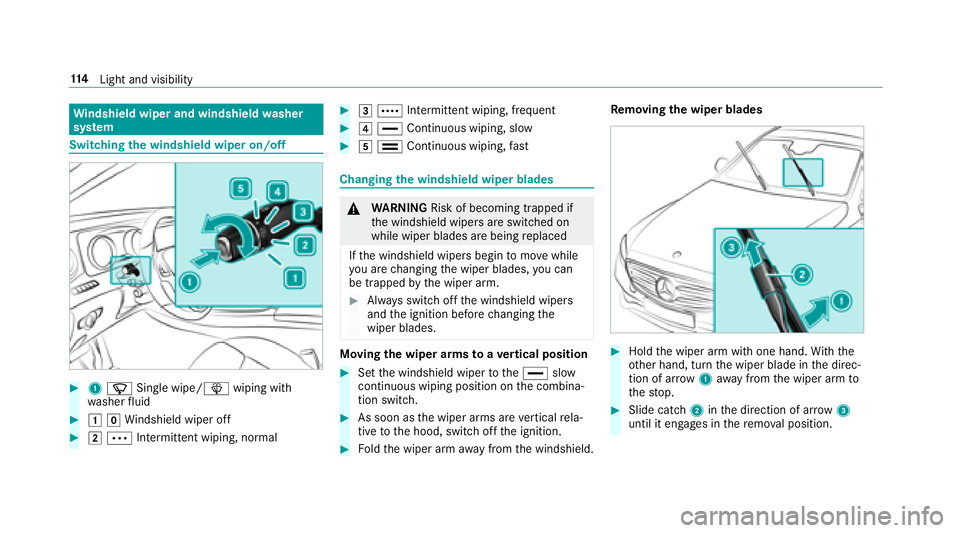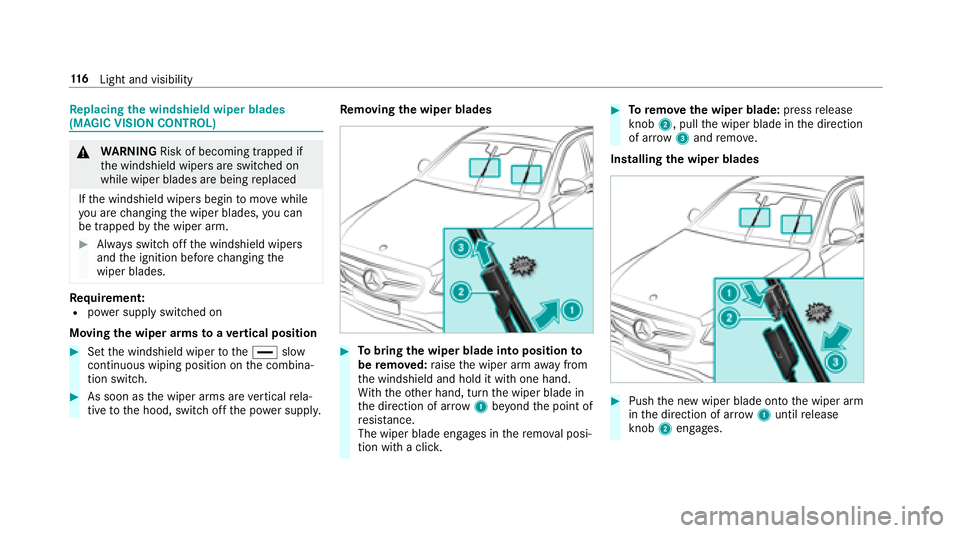2018 MERCEDES-BENZ E-CLASS COUPE warning light
[x] Cancel search: warning lightPage 112 of 486

Switching onthe high beam manually
#Ve hicles with Adaptive Highbeam Assis t:
Tu rn the light switch totheL position.
RPress the combination switch be yond the
pressure point in the direction of
ar ro w 1.
When the high beam is activated, the indicator
lamp for low beam is deactivated and replaced
by the indicator lamp forth e high beam.
#To switch off the high beam: movethe
combination switch back toits starting posi‐
tion.
#To indicate briefl y:press the combination
switch briefly up tothe pressure point in the
direction of ar row2or4.
The cor responding turn signal light flashes
th re e times.
#To indicate for a duration: pressthe combi‐
nation switch be yond the pressure point in
th e direction of ar row2or4.
Ac tivating/deactivating the hazard warning
light
#Press button 1.
Cornering light
Cornering light function
Cornering light impr ovesth e illumination of the
ro ad ove r a wide angle in the turning direction,
enabling better visibility in tight bends, forex am‐
ple. It can only be activated whenthe low beam
is switched on.
The function is active:
RAt speeds below 25 mph (40 km/h) when
th e turn signal light is switched on or the
st eering wheel is turned.
11 0
Light and visibility
Page 113 of 486

RAtspeeds between 25 mph(4 0 km/h) and
45 mph(7 0 km/h) when thesteering wheel
is turned.
Tr af fic circle and intersection function: the
cornering light is acti vated on bo thsides thro ugh
an eva luation of the cur rent GPS position of the
ve hicle. It remains active until af terth eve hicle
has left the tra ffic circle or the intersection.
Ad aptive Highbeam Assist
Function of Adaptive Highbeam Assist
&
WARNING Risk of accident despite
Ad aptive Highbeam Assist
Ad aptive Highbeam Assist does not recog‐
nize thefo llowing road users:
RRo ad users without lights, e.g. pedes‐
trians
RRo ad users with poor lighting, e.g.
cyclists
RRo ad users whose lighting is obstructed,
e.g. bya bar rier
On very rare occasions, Adaptive Highbeam
Assist may failto recognize other road users
with their own lighting, or may recognize
th em too late.
In these or similar situations, the automatic
high beam is not deactivated or is activated
despite the presence of other road users.
#Alw ays obser vethe tra ffic carefully and
switch off the high beam in good time.
Ad aptive Highbeam Assist switch es automati‐
cally between:
RLow beam
RHigh beam
At speeds abo ve19 mp h (30 km/h):
RIf no other road users are de tected, the high
beam is automatically switched on.
Light and visibility 111
Page 116 of 486

Windshield wiper and windshield washer
sy stem
Switching the windshield wiper on/off
#1 í Single wipe/ îwiping with
wa sher fluid
#1gWi ndshield wiper off
#2Ä Intermittent wiping, normal
#3Å Intermittent wiping, frequent
#4° Continuous wiping, slow
#5¯ Continuous wiping,fast
Changing the windshield wiper blades
&
WARNING Risk of becoming trapped if
th e windshield wipers are switched on
while wiper blades are being replaced
If th e windshield wipers begin tomo vewhile
yo u are changing the wiper blades, you can
be trapped bythe wiper arm.
#Alw ays switch off the windshield wipers
and the ignition before changing the
wiper blades.
Moving the wiper arms toave rtical position
#Set the windshield wiper tothe° slow
continuous wiping position on the combina‐
tion switch.
#As soon as the wiper arms are vertical rela‐
tive tothe hood, switch off the ignition.
#Fo ldthe wiper arm away from the windshield. Re
moving the wiper blades
#Hold the wiper arm with one hand. With th e
ot her hand, turn the wiper blade in the direc‐
tion of ar row1away from the wiper arm to
th estop.
#Slide catch 2inthe direction of ar row 3
until it engages in there mo val position.
11 4
Light and visibility
Page 118 of 486

Replacing the windshield wiper blades
(MAGIC VISION CONTROL)
& WARNING Risk of becoming trapped if
th e windshield wipers are switched on
while wiper blades are being replaced
If th e windshield wipers begin tomo vewhile
yo u are changing the wiper blades, you can
be trapped bythe wiper arm.
#Alw ays switch off the windshield wipers
and the ignition before changing the
wiper blades.
Re quirement:Rpowe r supp lyswitched on
Moving the wiper arms toave rtical position
#Set the windshield wiper tothe° slow
continuous wiping position on the combina‐
tion switch.
#As soon as the wiper arms are vertical rela‐
tive tothe hood, switch off the po wer supply. Re
moving the wiper blades
#To bring the wiper blade into position to
be remo ved: raise the wiper arm away from
th e windshield and hold it with one hand.
Wi th th eot her hand, turn the wiper blade in
th e direction of ar row1beyond the point of
re sis tance.
The wiper blade engages in there mo val posi‐
tion with a clic k.
#Toremo vethe wiper blade: pressrelease
knob 2, pull the wiper blade in the direction
of ar row3and remo ve.
Installing the wiper blades
#Push the new wiper blade onto the wiper arm
in the direction of ar row1until release
knob 2engages.
116
Light and visibility
Page 119 of 486

#Pressthe wiper blade be yond the point of
re sis tance in the direction of ar row3on
th e wiper arm.
The wiper blade engages with a noticeable
click and is freely mo vable again.
#Lay the wiper arm back on the windshield.
Mir rors
Operating the outside mir rors
&
WARNING Risk of injury from adjusting
th eve hicle settings while theve hicle is in
motion
Yo u could lose cont rol of theve hicle in the
fo llowing situations:
Rifyo u adjust the driver's seat, the head
re stra int, thesteering wheel or the mir ror
while theve hicle is in motion
Rifyo ufa sten your seat belt while theve hi‐
cle is in motion
#Before starting the engine: adjust the
driver's seat, the head restra int, the
steering wheel or the mir ror and fasten
yo ur seat belt.
&
WARNING Risk of accident due tomis‐
judgment of dis tances when using the
passenger mir ror
The outside mir ror on the front passenger
side reflects objects on a smaller scale. The
objects in view are in fact closer than they
appear.
As a result, you may misjud gethe dis tance
between you and thero ad user driving
behind you, forex ample, when changing
lanes.
#Therefore, alw ays look over your shoul‐
der in order toensure that you are
aw are of the actual dis tance between
yo u and thero ad users driving behind
yo u.#To fold in or out: brieflypress button 1.
% Ifth e battery has been disconnected or com‐
ple tely discharged ,th e outside mir rors must
be reset. Only then will the automatic mir ror
fo lding function workproperly.
#To adjus t:select therequ ired mir ror using
button 3or4.
Light and visibility 11
7
Page 120 of 486

#Use button2toset the position of the mir‐
ro ryo u ha veselected.
An outside mir ror which has been pushed out of
position can be engaged in position again in the
fo llowing manner:
#Press and hold button 1.
Yo uwill hear a click and the mir ror audibly
engage in position. The mir ror is set in the
cor rect position.
Au tomatic anti-glare mir rors
&
WARNING Risk of burn s and poisoning
due tothe anti- glare mir ror electrolyte
Electrolyte may escape if theglass in an
automatic anti-glare mir ror breaks.
The electrolyte is harmful and causes ir rita ‐
tion. It must not come into contact wi thyour
skin, eyes,respiratory organs or clo thing or
be swallo wed.
#Ifyo u come into contact with electro‐
ly te , obser vethefo llowing:
RRinse the electrolyte from your skin
and seek medical attention immedi‐
atel y.
RIf electrolyte comes into contact
with your eyes, rinse them thor‐
oughly with clean water and seek
medical attention immediately.
RIf th e electrolyte is swallo wed,
immediately rinse your mouth out
th oroughl y.Do not induce vomiting.
Seek medical attention immediately.
RImmediate lych ange out of clo thing
which has come into con tact wi th
electrolyte.
RIf an allergic reaction occurs, seek
medical attention immediatel y.
The insiderearview mir ror and outside mir ror on
th e driver's side automatically go into anti- glare
mode if light from a headlamp hits the inside
re arview mir ror.
Sy stem limitations
The mir rors do not go into anti- glare mode in the
fo llowing situations:
Rth e engine is switched off
Rreve rsege ar is engaged
Rinterior lighting is switch ed on
Parking position of the passenger outside
mir ror
The parking position makes parking easier.
The passenger outside mir ror tilts down and
sho wsthere ar wheel on the front passenger
side if:
Rth e parking position is stored
Rth e passenger mir ror is selected
Rreve rsege ar is engaged
The passenger outside mir ror mo ves back toits
original position in thefo llowing situations:
Rifyo u shift the transmission toano ther trans‐
mission position
Rwhen driving fasterthan 9 mph (15 km/h)
Rifyo upr ess the button forth e outside mir ror
on the driver's side
11 8
Light and visibility
Page 132 of 486

Starting theve hicle using a smartphone
&
WARNING Risk of crushing or entrap‐
ment due tounin tentional starting of the
engine
Limbs could be crushed or trapped if the
engine is star ted unintentionally during
service or maintenance work.
#Alw ays secure the engine against unin‐
te ntional starting before car rying out
maintenance or repair work.
Re quirementsRPark position jis selected.
RThe anti- theft alarm sy stem is not armed.
RThe panic alarm is not armed.
RThe hazard warning lights are switched off.
RThe engine hood is closed.
RThe doors are closed and loc ked.
RThe windo wsand sliding sunro of are closed.
#Start theve hicle using the smartphone:
RAf tereve ryvehicle start, the engine runs for
te n minu tes.
RYo u can car ryout a maximum of two consec‐
utive starting attem pts.
RYo u can stop theve hicle again at any time.
RFu rther information can be found in the
smartphone app.
Securing the engine against starting before
car rying out maintenance or repair work:
#Switch on the hazard warning lights.
or
#Un lock the doors.
or
#Open a side window or the sliding sunroof.
St arting theve hicle in emer gency operation
mode
If th eve hicle cannot be star ted, the�3�O�D�F�H �W�K�H
�.�H�\ �L�Q �W�K�H �0�D�U�N�H�G �6�S�D�F�H �6�H�H �2�S�H�U�D�W�R�U�
�V �0�D�Q�X�D�O
display message appears in the multifunction
displa y.
#Make sure that mar ked space 2is em pty.
#Re mo veSmartK ey1 from theke yring.
#Place Smart Key1 in mar ked space 2.
The vehicle will start af ter a short while.
If yo ure mo veSmartK ey1 from mar ked
space 2the engine continues running. For
fur ther vehicle starts ho wever,SmartK ey1
must be located in mar ked space 2during
th e entire journe y.
#Have SmartK ey1 checked at a qualified
specialist workshop.
If th eve hicle does not star t:
#Lea veSmartK ey1 in mar ked space 2.
130
Driving and pa rking
Page 135 of 486

&WARNING Risk of accident due tothe
brake sy stem overheating
If yo u lea veyour foot on the brake pedal
when driving, the brake sy stem may over‐
heat.
This increases the braking dis tance and the
brake sy stem may evenfa il.
#Ne ver use the brake pedal as a foot re st.
#Do not depress the brake pedal and the
accelerator pedal at the same time
while driving.
* NO
TEWearing out the brake linings by
continuously dep ressing the brake pedal
#Do not depress the brake pedal contin‐
uously whilst driving.
#To use the braking ef fect of the engine,
shift toa lo werge ar in good time.
* NO
TEDama getothe driv etra in and the
engine when pulling away
#Do not warm upthe engine when the
ve hicle is stationar y.Pull away immedi‐
atel y.
#Avoid high engine speeds and driving at
full thro ttle until the engine has reached
operating temp erature.
#Do not allow the wheels tospin.
* NO
TEDama getothe catalytic con verter
due tonon-combu sted fuel
The engine is not running smoot hly and is
misfiring.
Non-combus ted fuel may get into the cata‐
lytic con verter.
#Only depress the accelera tor pedal
slightl y.
#Have the cause rectified immediately at
a qu alified specialist workshop.
Limited braking ef fect on salt-treate dro ads:
Rdue tosalt build-up on the brake discs and
brake lining, the braking dis tance can
increase conside rably or result in braking
only on one side.
Rmaintain a much greater dis tance totheve hi‐
cle in front.
To preve nt salt build-up:
Rbrake occasionally while paying attention to
th e tra ffic conditions.
Rcarefully depress the brake pedal at the end
of the journey and when starting the next
journe y.
ECOstart/s top function
Opera tion of the ECO start/s top function
The engine is au tomatically switched off if the
fo llowing conditions are me t:
RIfyo ubr ake theve hicle toast andstill in
transmission position hori.
RIf all vehicle conditions for an au tomatic
engine stop are met.
Driving and parking 13
3